Theodor Wiegand – the famous excavator of Priene, Miletus and Didyma – began his career under unfavourable auspices. When he came to the DAI Athens, he was uncertain about his future. His time at the Institute, however, shaped him profoundly; it was here that he became the practical archaeologist and excavator as he is still known today.
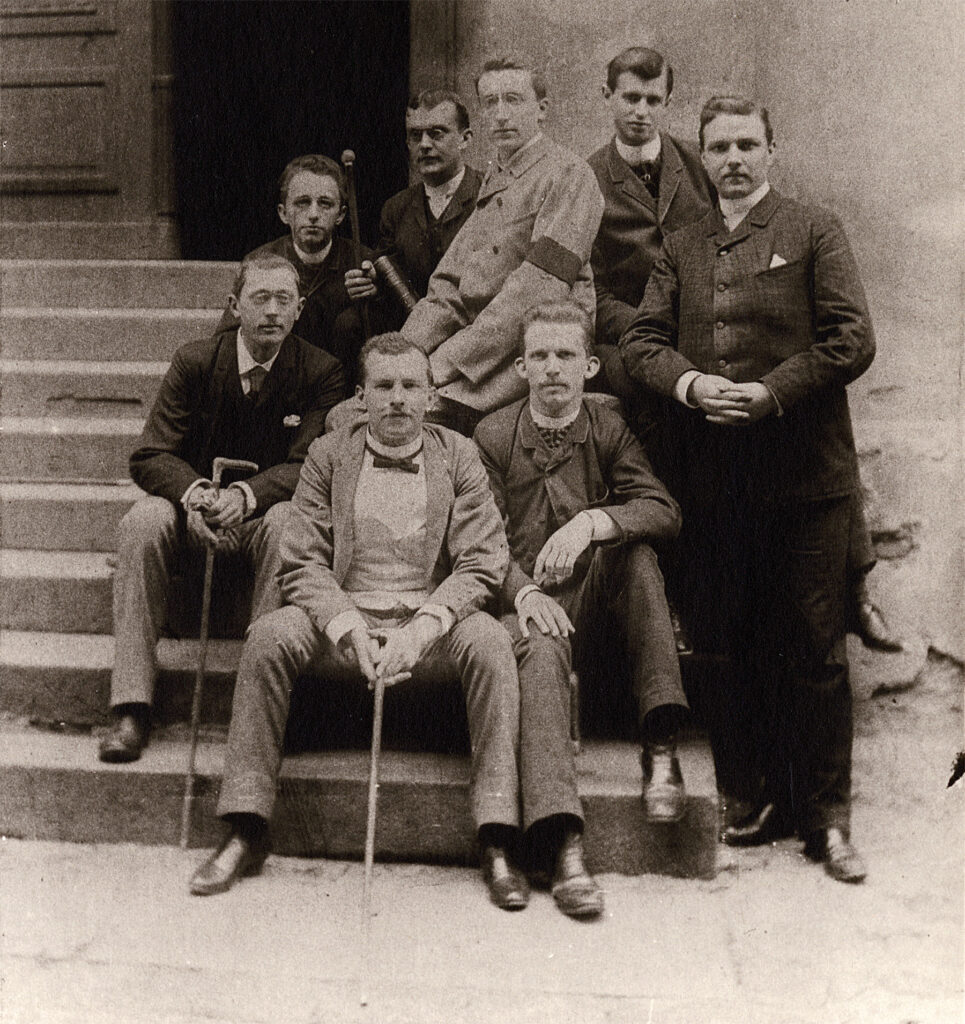
Much has been written about Wiegand, especially about his time in Asia Minor and thereafter, but less has been written about his early career. The most comprehensive treatment of Wiegand’s life is the problematic biography by Carl Watzinger, published in 1944. Watzinger presented Wiegand’s life in terms of Nazi ideology and accordingly did not incorporate all the information or name all his sources (e.g., Alfred Schiff, who was Jewish [Lehmann 2003]. Research in the archives of the DAI Athens and the Head Office (Archiv der Zentrale, hereafter AdZ), has led to the recovery of further information in Wiegand’s private papers (hereafter NL Wiegand), most notably letters from Theodor Fisher and Alfred Schiff to Carl Watzinger, as well as the original documents related to Wiegand’s travel grant.
Education
Theodor Wiegand was born 159 years ago (30 October 1864) in Bendorf am Rhein. He came from a prosperous family, but his parents had a dysfunctional marriage. Wiegand suffered from this situation and cited it as the reason why the course of his education was rich in detours (Watzinger 1944, 1–72; Althoff et al. 2016, 2 f.). In 1886, after difficult years at school, he graduated the Friedrichsgymnasium in Kassel at the age of 21 and began to study art history and classical studies in Munich. At the same time, he performed his military service, where he was praised for his »good command« (DAI, AdZ, NL Wiegand, Kasten 15, Diary entry 09.06.1889), a skill that later became evident in his excavations. He also was a dedicated member of the academic fencing fraternity Corps Suevia München (fig. 2).
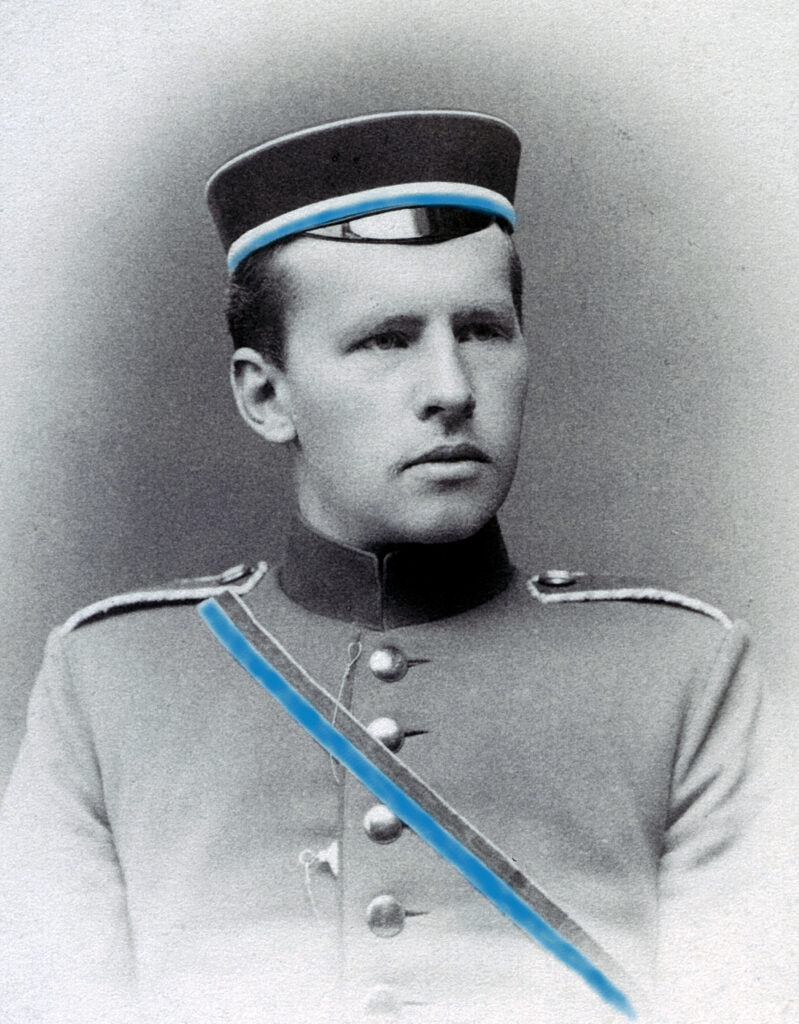
Wiegand enjoyed fencing even beyond the compulsory duels of his fraternity, receiving several scars in the process. Outside the fraternity scene, his scarred face struck many at first, but it also earned him respect, especially in the Ottoman Empire, where he was considered a »man of war« (DAI, AdZ, NL Wiegand, Kasten 15, Wiegand to I. Wiegand, 16.05.1895). Wiegand’s fraternity brothers teased him about his studies, because art history and classical studies, in contrast to medicine and law, were considered leisure activities. Wiegand, however, was not discouraged. He often discussed how best to become a good archaeologist with the aspiring orientalist Karl Dyroff, one of the few other humanists in the Corps. Wiegand believed that the modern arts provided the best starting point, whereas Dyroff, who had completed a degree in philology, thought that philology was a better approach (obituary of Theodor Wiegand by Karl Dyroff in the fraternity newspaper »Die Trausnitz« no. 31, March 1938, p. 3–7).
In the meantime, however, Wiegand’s studies had to take a back seat. In 1888, after five fruitless semesters in Munich, Wiegand pursued the idea of going abroad for inspiration, to help him decide whether he should continue studying archaeology or art history. He first inquired at the DAI Rome, but then First Secretary Eugen Petersen rejected his request, because Wiegand lacked preparatory studies – and because Petersen felt that the distractions of Rome would not help the young, unfocused student (Watzinger 1944, 36). Wiegand was not discouraged by the rejection. He decided instead to spend a semester in Athens with his school friend from Kassel, the aspiring publisher and writer Theodor Fisher.
Fisher had left for Athens only a few months earlier. He was working as a volunteer in the Wilberg bookshop and rooming in the house of the owner, Mrs Wilberg, widow of Consul Wilberg (DAI, AdZ, NL Wiegand, Kasten 43, Th. Fisher’s recollections of Wiegand, August 1937, p. 15). Fisher was delighted by Wiegand’s visit and introduced him to the growing German society in Athens. The luncheon of the German-Greek Society Philadelphia was an important meeting place, where Wiegand first made contact with the young archaeologists from the DAI Athens. According to Fisher, Wiegand was dreading the meeting because he knew so little about archaeology, despite being an advanced student (DAI, AdZ, NL Wiegand, Th. Fisher’s recollections of Wiegand, August 1937, p. 16 f.).
But his fear was unfounded: the young scholars took Wiegand under their wing and he benefited from their different academic approaches (Watzinger 1944, 38 f.). He became close friends in particular with Bruno Sauer and Botho Graef. The former studied the composition of the Parthenon pediment group, which he sketched high up in situ. The latter dealt with the ceramic finds from the so-called Perserschutt, impressing Wiegand with his skilled eye. Wiegand also accompanied the other travel grant holders as an eager student: Alfred Brueckner examined the archaic pediment group of the Acropolis. According to Watzinger, Arthur Schneider involved Wiegand in the work on the ceramics from the Dionysos Theatre. Josef Strzygowski, in contrast, introduced Wiegand to Byzantine art and history, a topic that he pursued later himself.
Wiegand not only received support from the travel grant holders (Watzinger 1944, 40 f.). He admired Paul Wolters, the Second Secretary, for his extensive knowledge of literature and monuments, but he recoiled from Wolters’s strict manner. Instead, he established a friendship with the architects Karl Herold and Georg Kawerau. He also took drawing lessons from the Swiss painter Emile Gilliéron (Mertens – Conte 2019), which later blossomed into a collaboration. His greatest mentor was Wilhelm Dörpfeld himself, then First Secretary of the DAI Athens. Wiegand soon embarked on a project of his own. The scholarship holders Graef and Brueckner had suggested that the simae of the archaic poros-stone architecture on the Acropolis deserved to be recorded in drawings. Wiegand threw himself into the task and presented his first results to Dörpfeld. Dörpfeld immediately took interest and suggested publishing the sketches in the Antike Denkmäler edited by the DAI Berlin (fig. 3). In addition, Dörpfeld let Wiegand participate in the excavation at the Dionysos Theatre in spring 1889. This was Wiegand’s first experience as an excavator. Wiegand later described Dörpfeld as his first teacher in archaeological matters (DAI, AdZ, Biographicamappe Theodor Wiegand, Travel grant report by Wiegand, 28.03.1898).
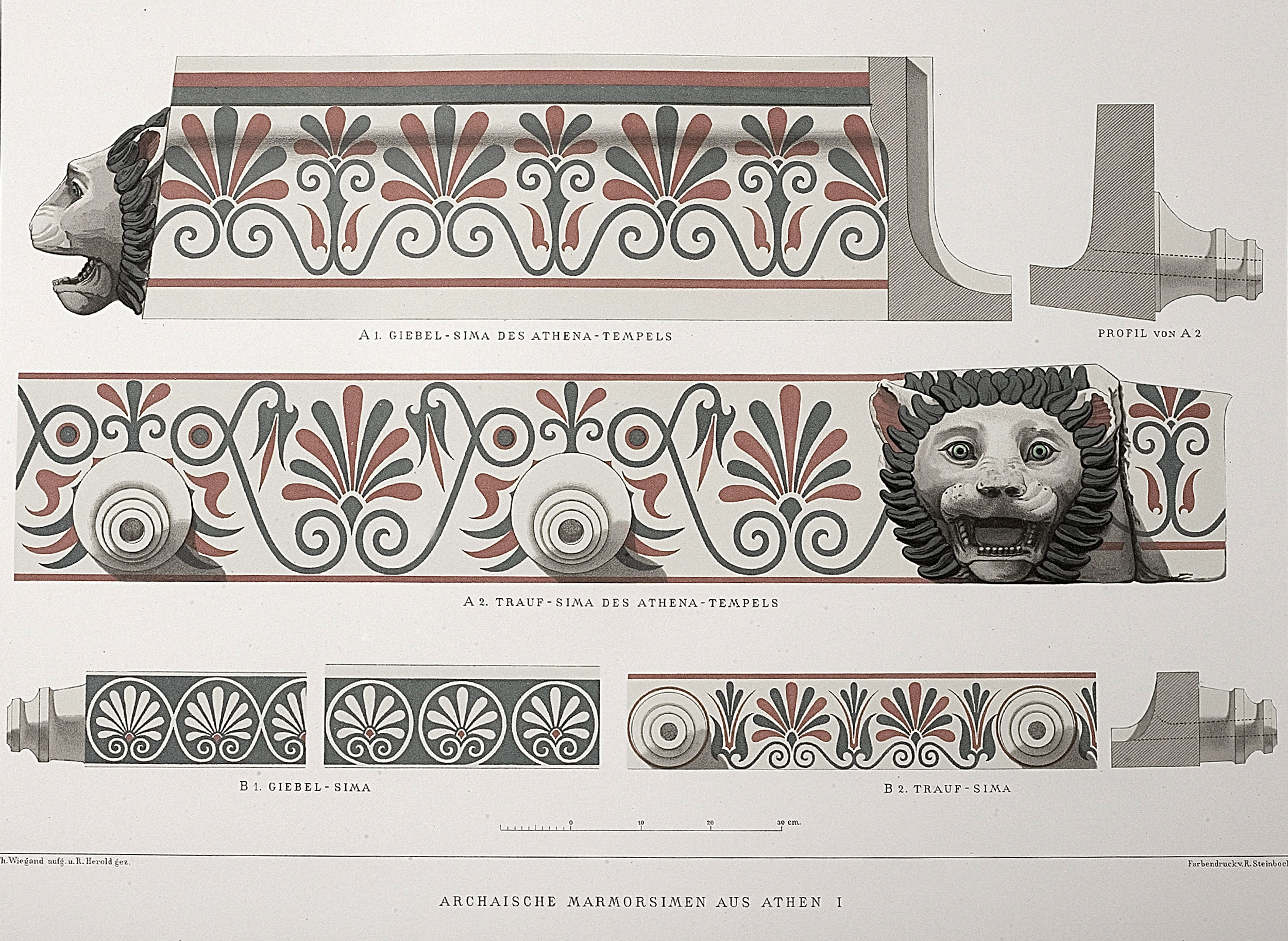
At the Institute, Wiegand’s thirst for knowledge received new stimuli daily from the lively discussion of constant new discoveries (Watzinger 1944, 39–43). He informed his parents that his stay abroad had truly served its purpose. He was studying from morning until night (DAI, AdZ, NL Wiegand, Kasten 15, Wiegand to I. Wiegand, 04.11.1888). Fisher describes Wiegand’s daily routine as follows: he spent his mornings on the Acropolis or in the museums. Before the Philadelphia luncheon, Wiegand sometimes met Fisher and others for a Mastika and coffee afterwards. In the afternoons, Wiegand worked diligently before they spent the evenings together convivially (DAI, AdZ, NL Wiegand, Th. Fisher’s recollections of Wiegand, August 1937, p. 19). Social events took place mainly at the Philadelphia and at the Dörpfelds’. Heinrich Schliemann was also an important authority in Athens, as was his wife Sophia, to whom Wiegand was introduced. (DAI, AdZ, NL Wiegand, Kasten 15, Diary entry 11.12.1888). In the colder months, Wiegand and Fisher undertook many hikes with the archaeologists from the Institute around Attica, among others to Piraeus, Tatoi, Kephisia, Pentelikon and Eleusis (fig. 4) (DAI, AdZ, NL Wiegand, Th. Fisher’s recollections of Wiegand, August 1937, p. 21). In March 1889, Wiegand took part in the Peloponnese trip that Dörpfeld organised every year (Sporn 2020).
During this first sojourn in Athens, Wiegand established many friendships, some of which accompanied him throughout his life. In practical terms, the fact that he was introduced to the various areas of archaeology and was thus motivated to continue his studies was especially formative. He wrote to his friend Fisher that he was determined »to devote himself now to his archaeological studies with all his energy« (DAI, AdZ, NL Wiegand, Th. Fisher’s recollections of Wiegand, August 1937, p. 22). His subsequent stay in Rome confirmed this decision. Wiegand travelled there at the beginning of May, but was rather depressed by the abundance of material he found, as it became clear to him that his knowledge was still limited.
In order to devote himself to his studies, Wiegand moved from Munich to Berlin, where he began to study classical studies intensively. He chose to specialise in ancient architecture under Otto Puchstein (Watzinger 1944, 46–53; Althoff et al 2016, 6). In Berlin, Wiegand was able to maintain his Athenian acquaintanceships. Thus, he continued to be influenced by Graef, who had just finished his Habilitation in Berlin. He also met Ludwig Pallat and Hans Schrader in Berlin, with whom he was to have a lifelong friendship. He even became Schrader’s brother-in-law in 1901. In 1891 Wiegand continued his studies with Franz Studniczka in Freiburg im Breisgau for health reasons (Watzinger 1944, 53). He was Studniczka’s first and, at the time, only archaeology student. At almost 30 years of age, in 1893, Wiegand received his doctorate from Studniczka with the thesis »Die puteolanische Bauinschrift sachlich erläutert«.
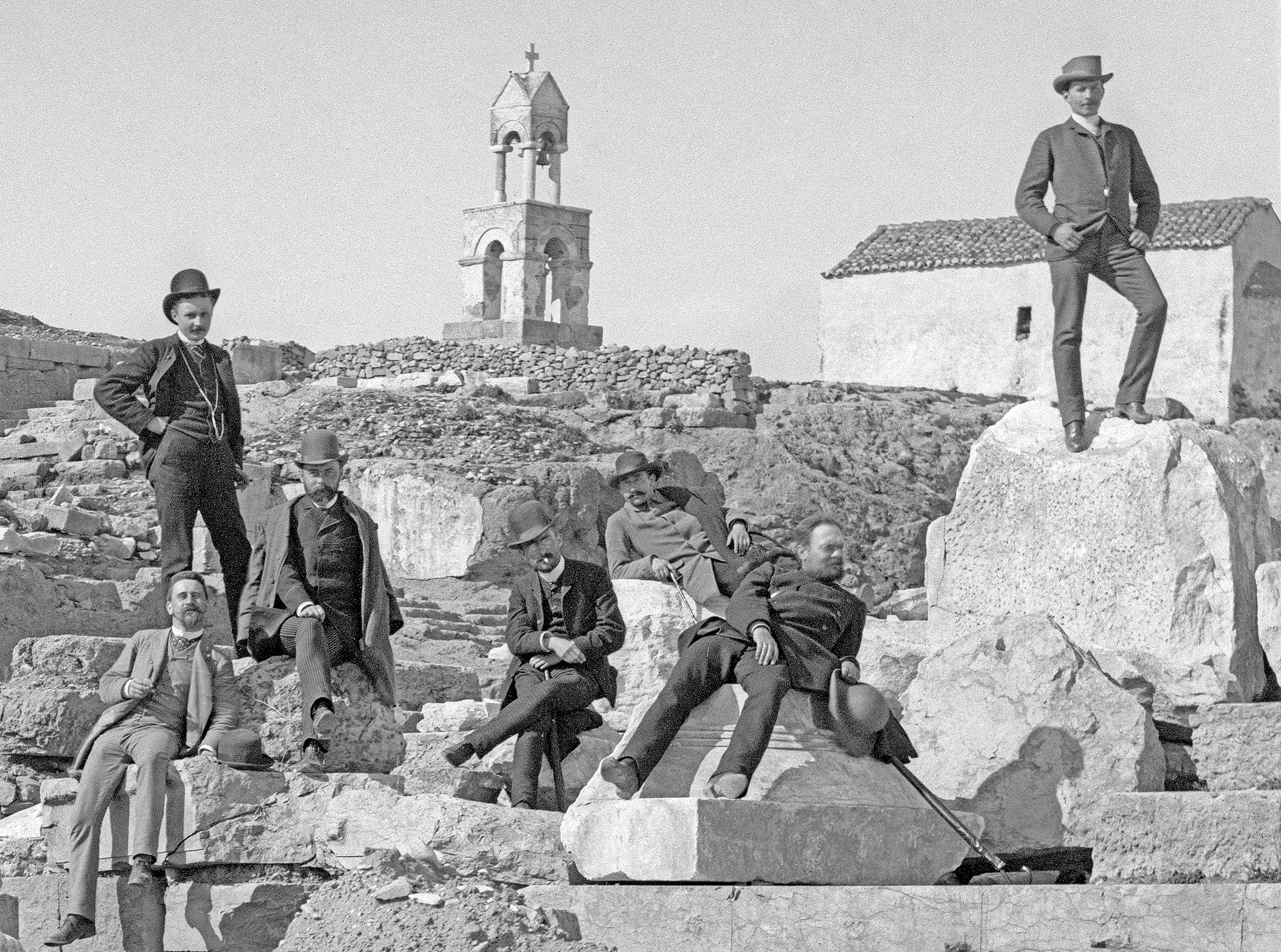
Travel grant
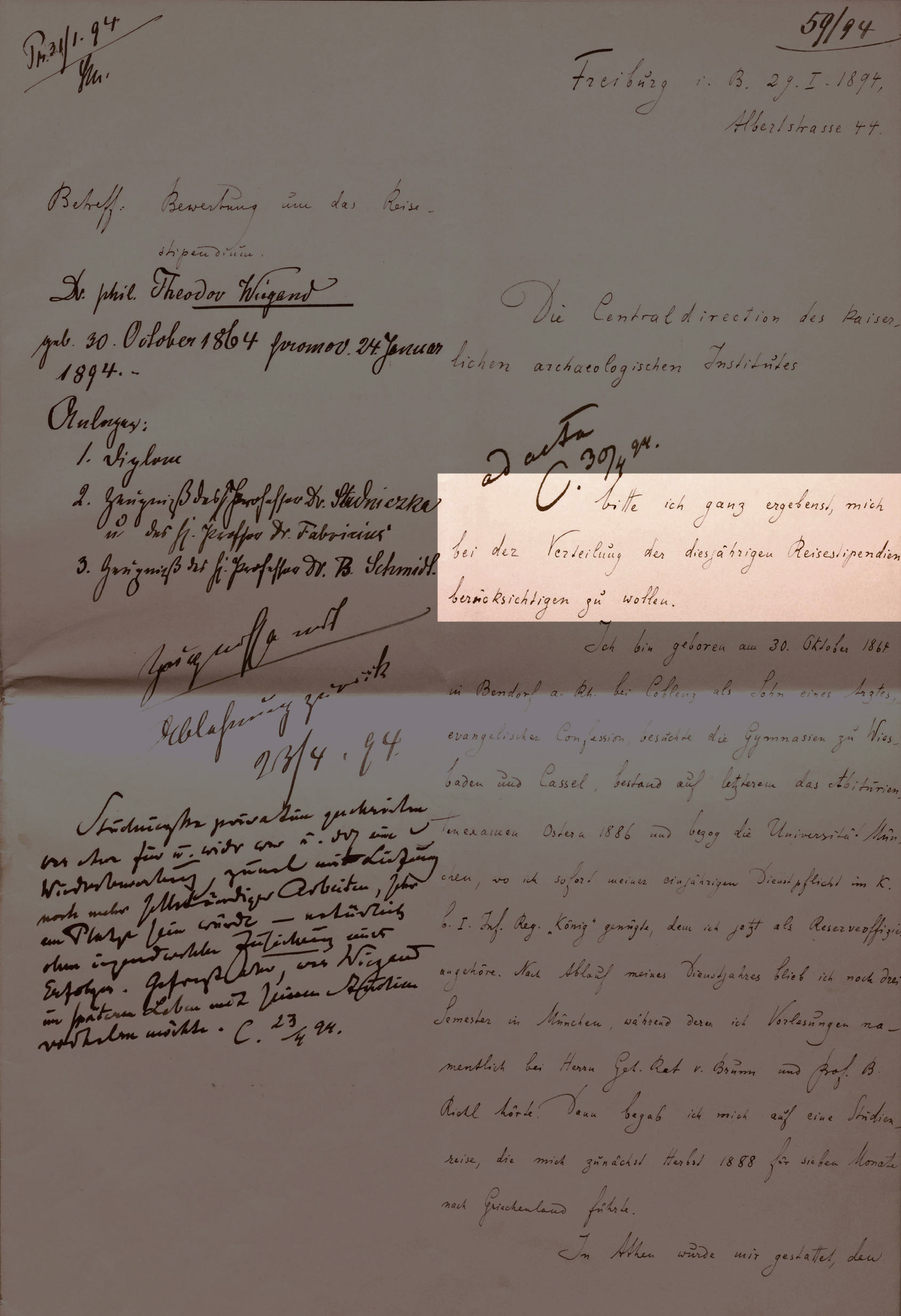
On 1 February 1894, Wiegand submitted his application for the travel grant (fig. 5). Professors Studniczka, Ernst Fabricius and Bernhard Schmidt had written reports on Wiegand’s qualification. On the same day, Wiegand wrote in his diary that he had not read these reports and doubted whether there was anything positive in them (DAI, AdZ, NL Wiegand, Kasten 15, Diary entry 01.02.1894). Unfortunately, his fears were well-founded. Although his dissertation was praised by other archaeologists, such as Otto Puchstein, and even by the philologist Ulrich von Wilamowitz, Studniczka rated it multa cum laude (Althoff et al 2016, 1. 6). In a letter to Alexander Conze, Studniczka wrote that Wiegand was suited neither for an academic career nor – because of his age – that of a grammar school teacher. He could imagine Wiegand instead in a small, provincial museum at the Limes (fig. 6).
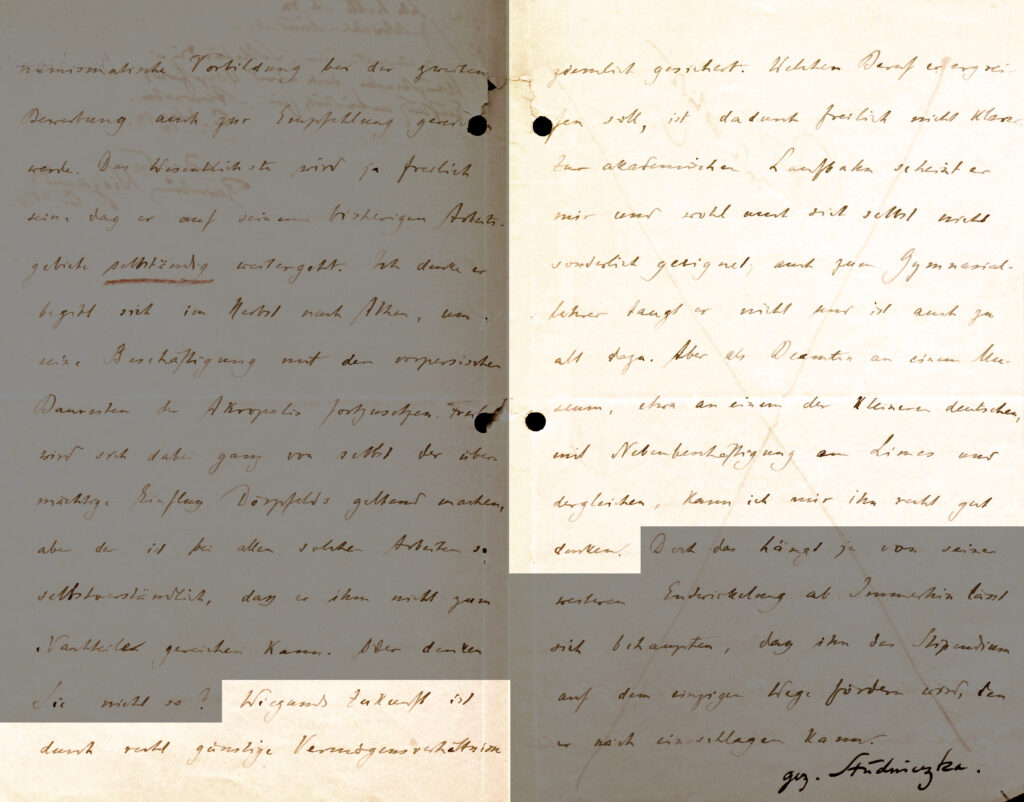
Wiegand doubted his own abilities, presumably because Studniczka had been heavily involved in his doctoral thesis and he felt far inferior to his teacher. Thus, in 1894, he found himself in a kind of crisis (Watzinger 1944, 56–61; Althoff 2004, 140). While waiting for the decision of the Centraldirection (Central Committee, the scientific board of the Institute) regarding the travel grant, he received an invitation to come to London and spent three months there, followed by a month in Copenhagen. In London, Studniczka informed him that his application for the travel grant had been rejected.
In his application, Wiegand had written that he had worked on the archaic simae of the Acropolis during his first stay in Athens in 1888/1889 and now planned to pursue this project further with the help of the scholarship. Dörpfeld attested to his previous work and affirmed that its continuation was worthwhile, recommending him for the travel grant (DAI, AdZ, Biographicamappe Theodor Wiegand, Letter of recommendation for Wiegand from W. Döprfeld, 12.03.1894). Dörpfeld’s encouragement apparently outweighed his rejection by the Central Committee, because Wiegand decided to go back to Athens anyway to work on the poros architecture as planned. On 7 December 1894, he set off on his second journey to Greece via Italy. He reached Rome at noon on 19 December, where his friends Pallat, Schrader and Schiff welcomed him. Soon after, leaving the afternoon of 22 December, he travelled together with Pallat and the travel-grant holder Schrader to Athens via Brindisi (Watzinger 1944, 60f.).
Sojourn in Athens 1895/1896
The familiar surroundings in Athens seemed to give Wiegand new courage to face life after his transitional crisis. From the very beginning, he was treated the same as the travel grant holders. Wiegand took turns supervising the excavations on the western slope of the Acropolis with them. In the process, he found an inscription in a well cut into the rock that identified the district as a sanctuary of Amynos, where Asclepius and the poet Sophocles as the hero Dexion had also been worshipped (Watzinger 1944, 62).
As Conze had advised Wiegand the year before, he applied for the travel grant again. His main occupation, as originally planned the year before, would be his work on the poros architecture. He therefore sent his current report to the Centraldirektion in Berlin on 8 April 1895 (fig. 7).
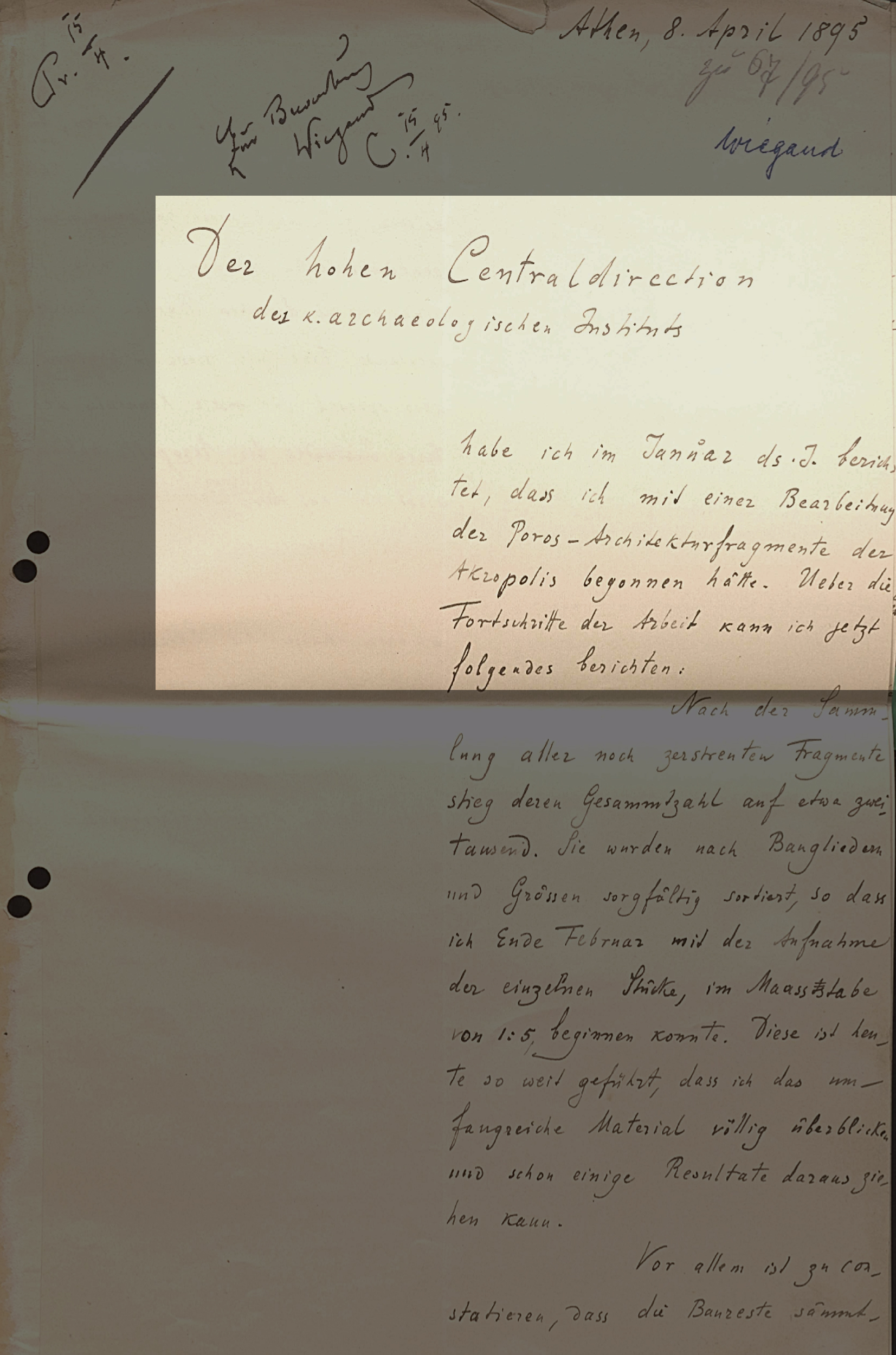
On the same day, Dörpfeld and Wolters sent a letter to Berlin, praising Wiegand’s work and recommending him once again for the travel grant (DAI, AdZ, Biographicamappe Theodor Wiegand, Letter of recommendation for Wiegand from W. Dörpfeld and P. Wolters, 08.04.1895). Soon afterward, also in April 1895, he again joined Dörpfeld’s annual Peloponnese trip and the subsequent tour across the Aegean islands to Troy (Watzinger 1944, 63). During this trip, Wiegand learned that his second application had been successful. In autumn 1895, he was awarded the travel grant together with Hans Dragendorff, Carl Fredrich, Carl Schmidt, and Schrader (fig. 1). The poros architecture remained his primary focus although Wiegand also began to pursue other projects, including his first independent excavation.
Excavation in Old Phaleron
On Easter Sunday, 14 April 1895, shortly before the start of the Peloponnese trip, Wiegand, Schiff and Pallat went for a stroll in Old Phaleron. While doing so, they came across the remains of an ancient villa by the sea, some of the walls of which still stood as high as 1–1.5m above the ancient floor; remnants of wall paintings could be seen on them (Watzinger 1944, 63). According to Schiff (DAI, AdZ, NL Wiegand, Kasten 43, Diary entries by A. Schiff, 1895), Wiegand was immediately enthusiastic about the discovery and wanted to carry out an excavation. He talked about his idea with Dörpfeld, who applied for and obtained an excavation permit (fig. 8) from the general Ephoros of Antiquities Panagiotis Kavvadias (Chatzidimitriou 2019, 141–143 fig. 4).
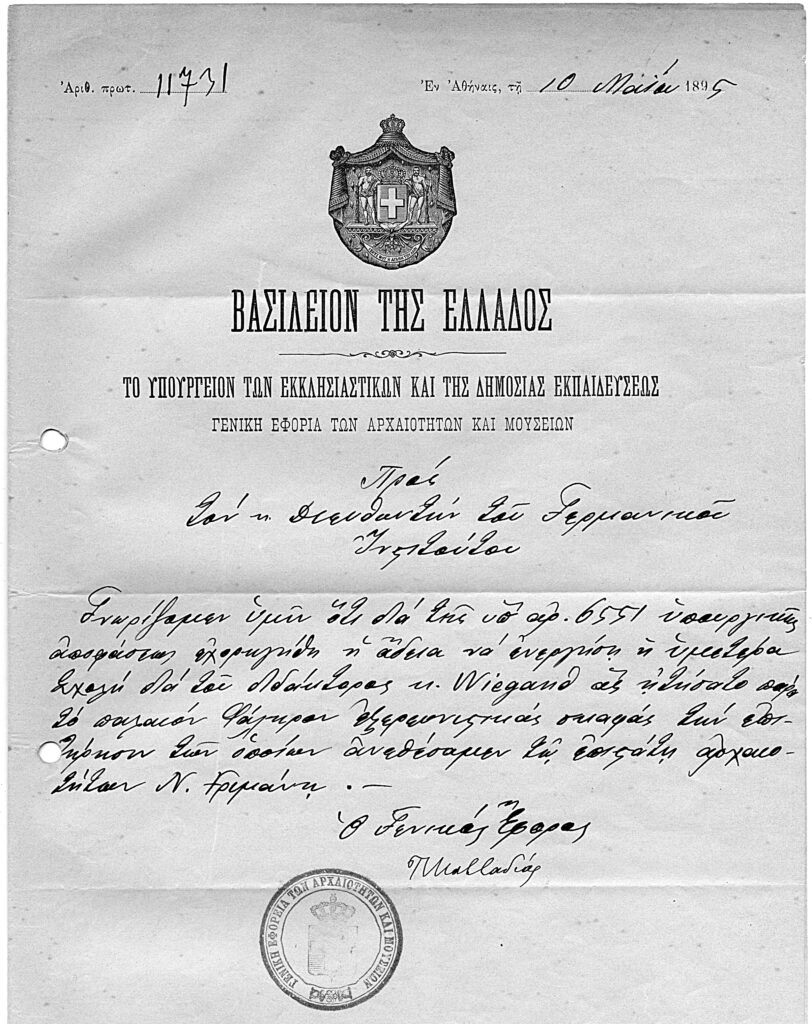
On 22 May 1895, that is, immediately after the Peloponnese trip, Wiegand was allowed to begin his excavation at the Institute’s expense, but it was interrupted a week later until mid-July »due to local obstacles« (DAI, Berlin, AdZ, NL Wiegand, Theodor, Kasten 45, Mappe Kap Kolias, 01-01, Excavations at Cape Kolias, May-July1895). On 11 August 1895, Wiegand finished the excavation of his »villa by the sea« (DAI, AdZ, NL Wiegand, Kasten 43, Diary entries by A. Schiff, 1895) and planned to publish it in the Athenische Mitteilungen. He presented his results in the lecture series of the DAI Athens on 8 January 1896, but he hesitated to submit his manuscript for publication (fig. 9).
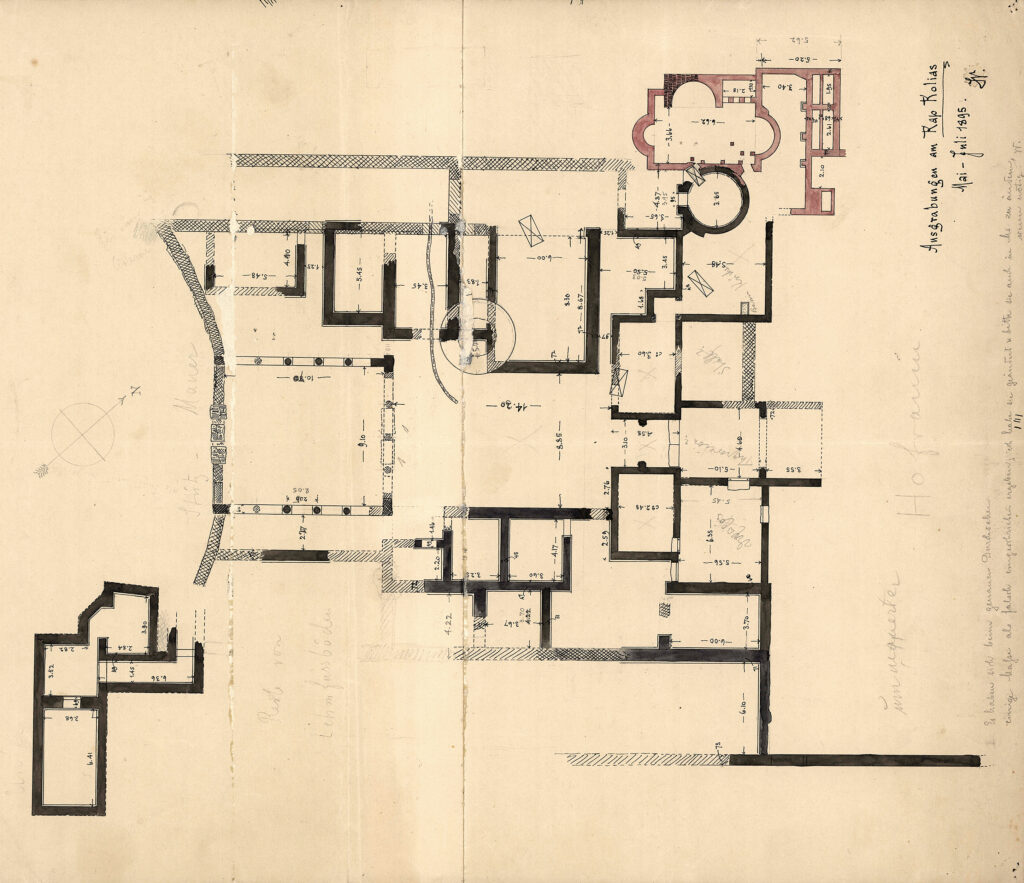
In his final report for his scholarship, he justified his hesitation by arguing that he hoped to get to know the comparative findings, especially the villa in Boscoreale, »by seeing them for himself« (DAI, AdZ, Biographicamappe Theodor Wiegand, Travel grant report by Wiegand, 28.03.1898). Unfortunately, his excavation report was never published. A few of the finds (fig. 10) eventually ended up in the archaeological collection of the DAI Athens. They presumably arrived at the Institute between 1901 and 1905, because Schrader, then being the second secretary, wrote the find labels. The fragments were cleaned by the conservator Angelos Sotiropoulos in 2021 as part of the BMBF project Shapes of Ancient Greece (SAG). I am currently preparing an article on the villa and its finds within the framework of the same project.
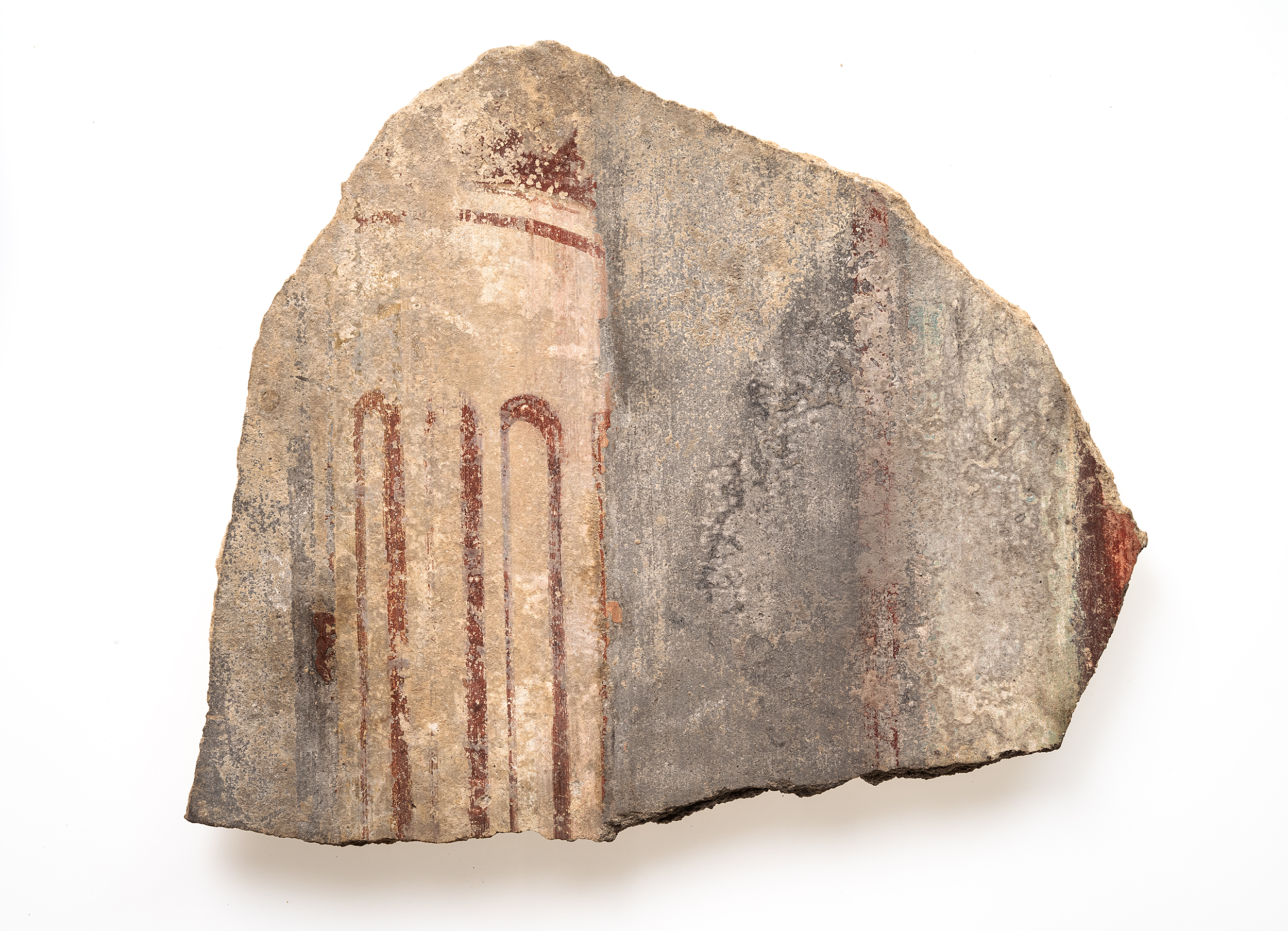
Euboea trip
While his excavation in Phaleron was interrupted, Wiegand undertook a trip across the island of Euboea with Schrader and the architect Wilhelm Wilberg (Watzinger 1944, 63 f.). Wiegand kept a travel diary (figs. 11. 12), describing the route, conditions, landscape and the archaeological findings. The journey began on 4 June and ended around 11 July, the date of the last entry.
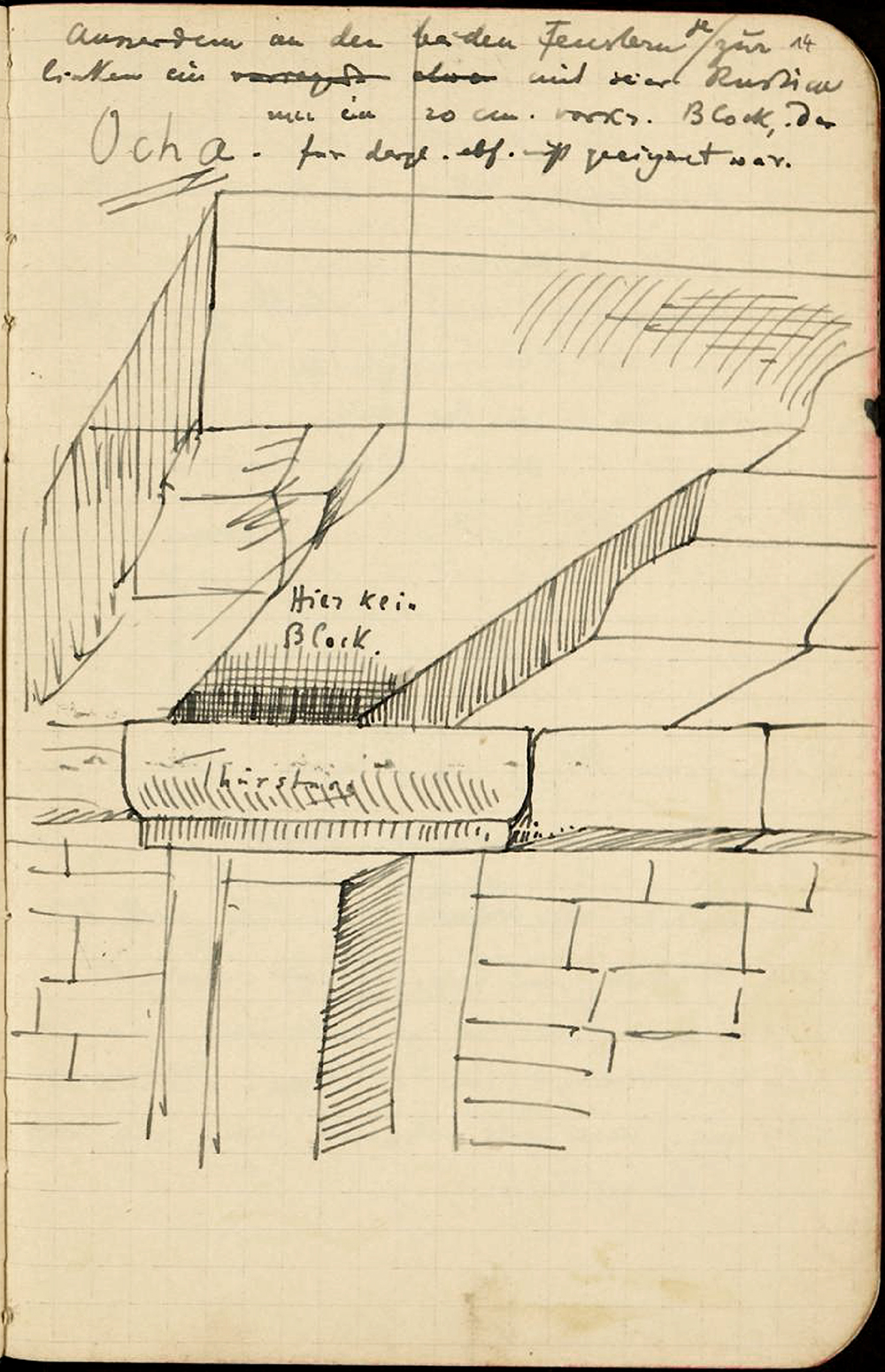
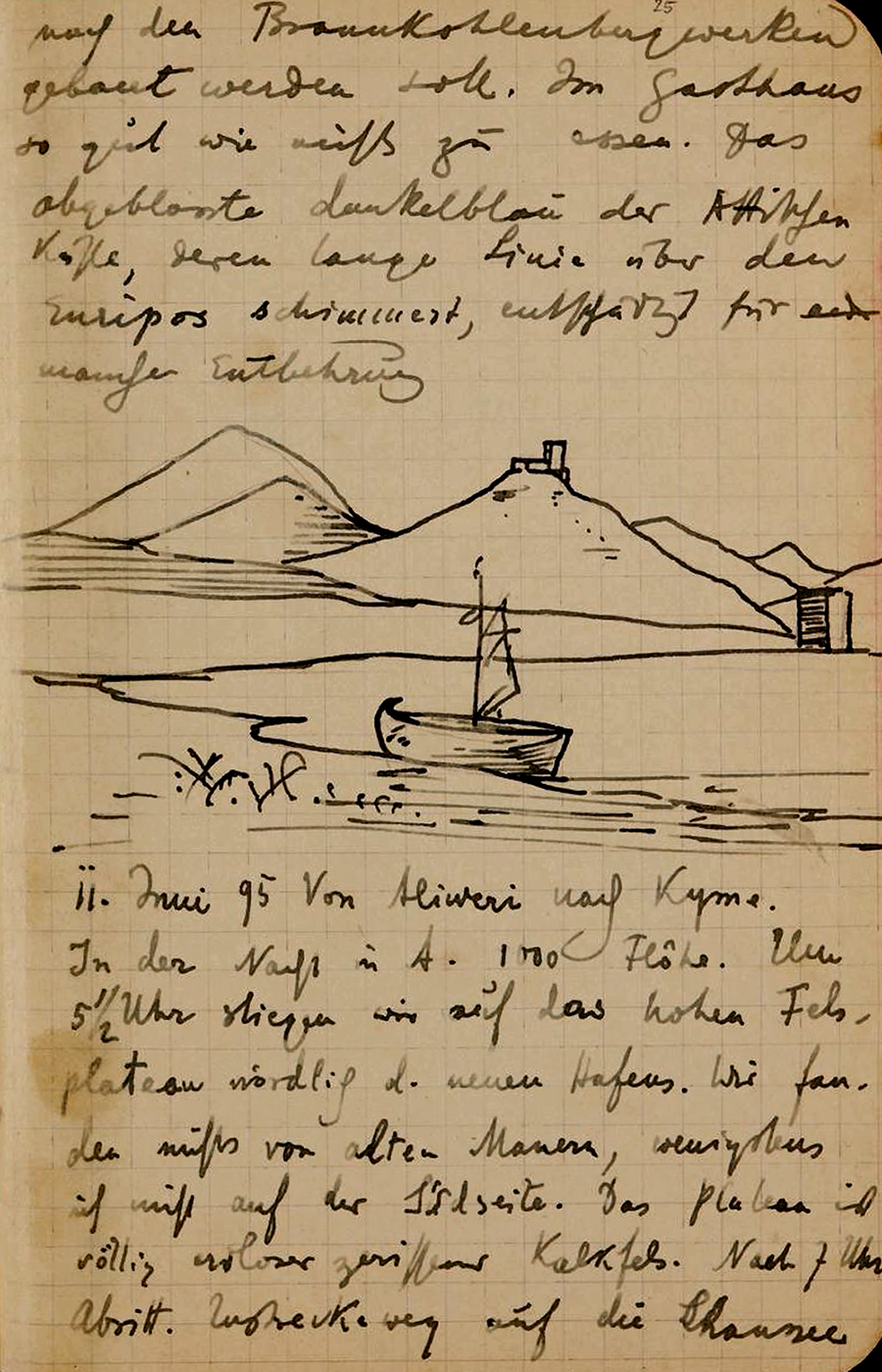
In his final report (DAI, AdZ, Biographicamappe Theodor Wiegand, Travel grant report by Wiegand, 28.03.1898), he retraced his itinerary and highlighted the most important achievements. They investigated the building on the highest peak of the Ocha, which at the time was widely believed to have been a temple, but which they interpreted as a guardhouse. Wiegand published his reflections on the »Urtempel« on the Ocha in 1896 in the Athenische Mitteilungen. Their plan of the ancient city in the marshy plain of Dystos also appeared there.
At the beginning of 1896 Wiegand gave presentations on his three major projects at the DAI Athens during his travel grant period – the villa in Old Phaleron (8 January), the trip to Euboea (19 February), and the poros architecture (18 March; AM 21, 1896, 264).
Poros architecture
Wiegand continuously worked on the poros architecture, which had occupied him, with many interruptions, since 1888. He tried to attribute the scattered fragments to specific lost buildings to get an overview of the number of archaic buildings on the Acropolis and their appearance (Watzinger 1944, 68 f.). Wilberg, with whom Wiegand had travelled through Euboea, drew the fragments (Vignau-Wilberg 2022, 34 f.). They were subsequently assembled and exhibited, in part, in the ‘Small Acropolis Museum’ (Watzinger 1944, 74). Wiegand spent the summer of 1898 back in Athens, recovering from illness, where he used the time to study the poros architecture even more intently (Watzinger 1944, 84). He wanted the painter Gilliéron, who had given him drawing lessons in 1888/1889, to produce coloured pictures of the material, but his financial means were not sufficient for Wilberg and Gilliéron. Therefore, on Conze’s advice, he applied for the Eduard Gerhard scholarship in order to finance his collaborators. It was not until spring 1901 that Wiegand was able to complete his work and prepare his results for publication (figs. 13. 14).
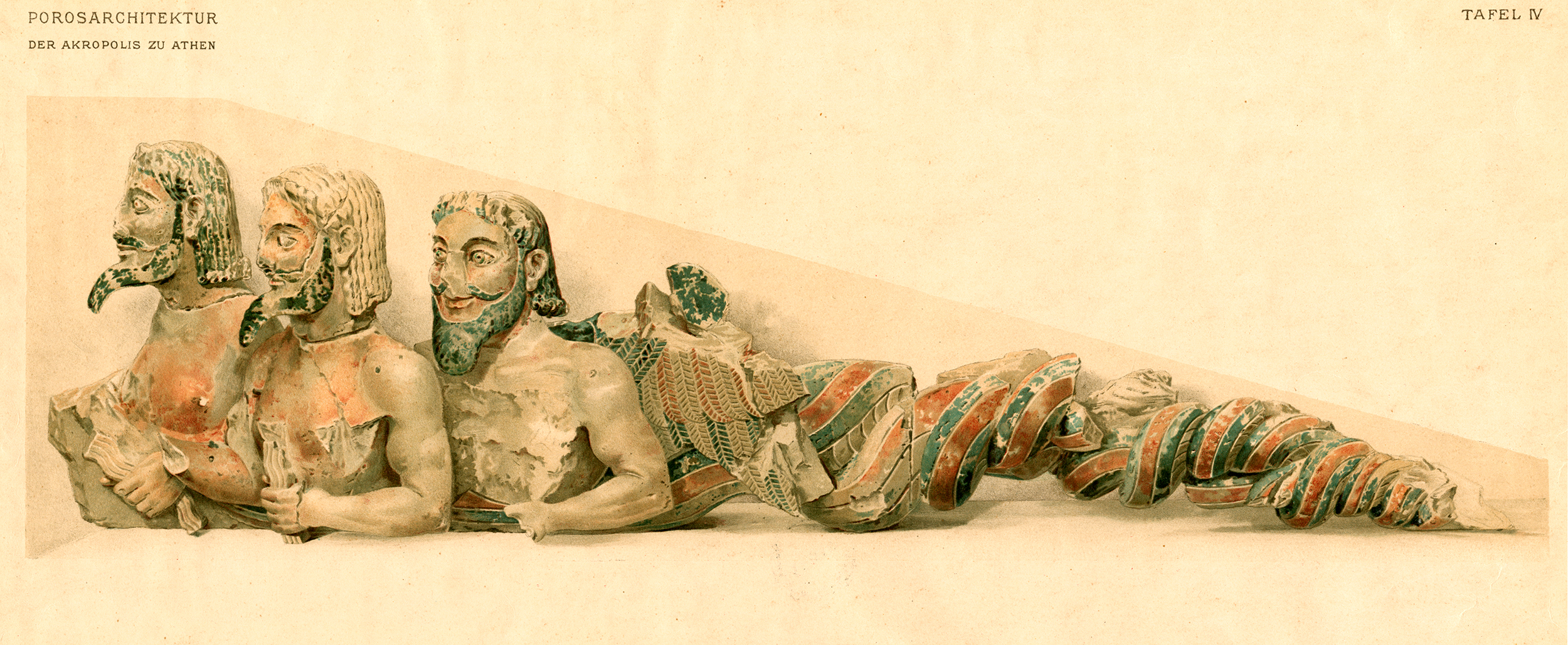
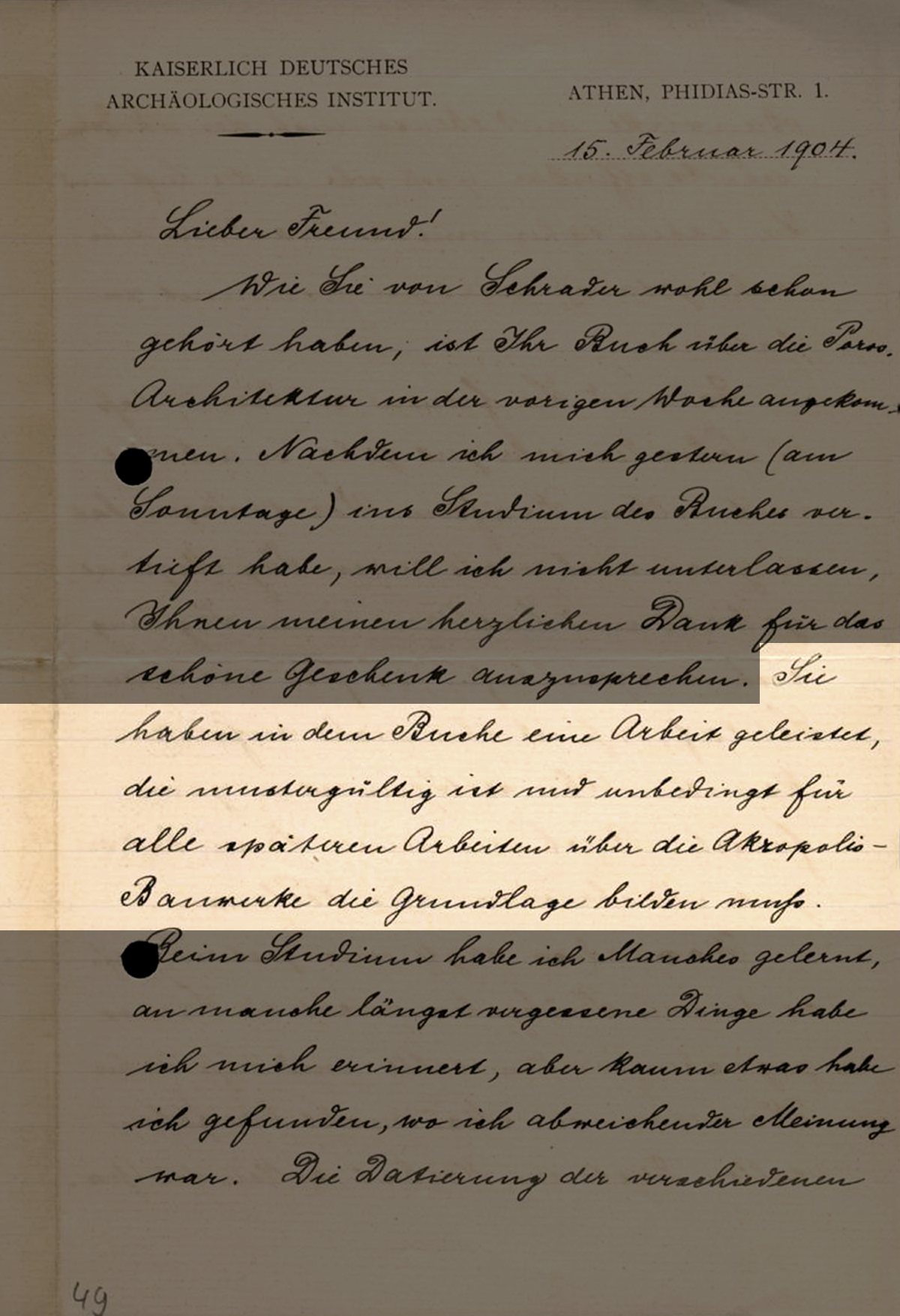
Departure to Asia Minor
In September 1895, Wiegand was offered a special opportunity that ultimately determined his future career. Reinhard Kekulé von Stradonitz, Director of the Ancient Sculptures and Plaster Casts Collection of the Königliche Museen in Berlin, travelled to Priene to inaugurate Carl Humann’s excavation there, which had been commissioned by the Berlin Museums. On the way, Kekulé stayed in Athens, where Schrader was to join him as Humann’s assistant. Schiff writes in his diary about the meeting at Dörpfeld’s house in Kifissia on 13 September 1895, where the position as assistant was discussed, because Schrader had not yet completed his work on the archaic marble sculptures of the Acropolis. Kekulé believed that Schrader should finish his work first so as not to lose momentum. He therefore suggested that his friend Wiegand should replace him as an interim appointment. They agreed and so, at the end of September, Kekulé called Wiegand to Priene as Humann’s assistant (DAI, AdZ, NL Wiegand, Kasten 43, Diary entry by A. Schiff, 13.09.1895; Watzinger 1944, 64 f.; Althoff 2004, 135 f.).
Wiegand’s abilities were soon put to the test when Humann fell ill shortly after the excavation began, and Wiegand took over as substitute director. After Humann’s death on 12 April 1896, Wiegand was officially made director of the excavation and, provisionally, was entrusted with Humann’s other tasks in order to represent the interests of the Prussian Museums in Asia Minor (Althoff et al 2016, 1 f.). This meant a great leap forward in his career, but it spoiled his original plans. Wiegand had applied in January 1896 for a continuation of the travel grant. He wanted to travel to Sicily and Southern Italy to answer questions concerning Greek house building in Priene and Phaleron. He also had not yet been able to complete his work on the poros architecture. Wiegand received the extension in Autumn 1896, but he remained mainly in Asia Minor because of his newly assigned tasks. In 1899, he officially became Director of the Prussian Museums in the Ottoman Empire (fig. 15).
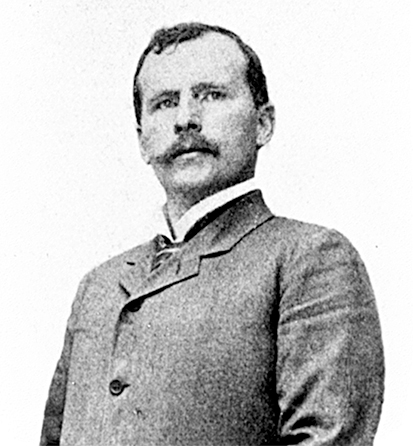
After Priene, Wiegand directed the excavations at Miletus and Didyma and represented German interests in the Ottoman Empire, about which much has been written controversially (for further reading, see most recently Althoff et al. 2016; Puritani et al. 2022). He continued to do so even after he became Director of the Berlin Antiquities Collection in 1911 and moved in the magnificent villa in Berlin/Dahlem, the so-called Wiegand House, now the headquarters of the DAI (Rheidt – Lutz 2004).
Ongoing connection to the DAI Athens
Wiegand’s close contact with the DAI Athens did not end, however, with his departure for Asia Minor in 1895. Wiegand had established many friendships in Athens that he continued to cultivate through mutual exchange and support. His collaboration helped to launch projects that still exist today. After already publishing on sculpture from Samos in 1900, he initiated the excavation at the Heraion of Samos, which was continued by the DAI Athens from 1925 (Kyrieleis 1981). Wiegand was also involved in the Pergamon excavation resumed by Conze and Dörpfeld in 1900, in which he began to participate in 1905 (Watzinger 1944, 191 passim).
In 1932, Wiegand was elected president of the German Archaeological Institute (fig. 16). As president, Wiegand was member of the committee of the XI Olympiad in Berlin, where he successfully campaigned for the resumption of the Olympia excavation (so-called Führergrabung), which had been discontinued in 1930 (Watzinger 1944, 453–455; Althoff et al 2016, 29; further reading Kankeleit 2018). This was one of his last major acts before he died in Berlin on 19 December 1936.
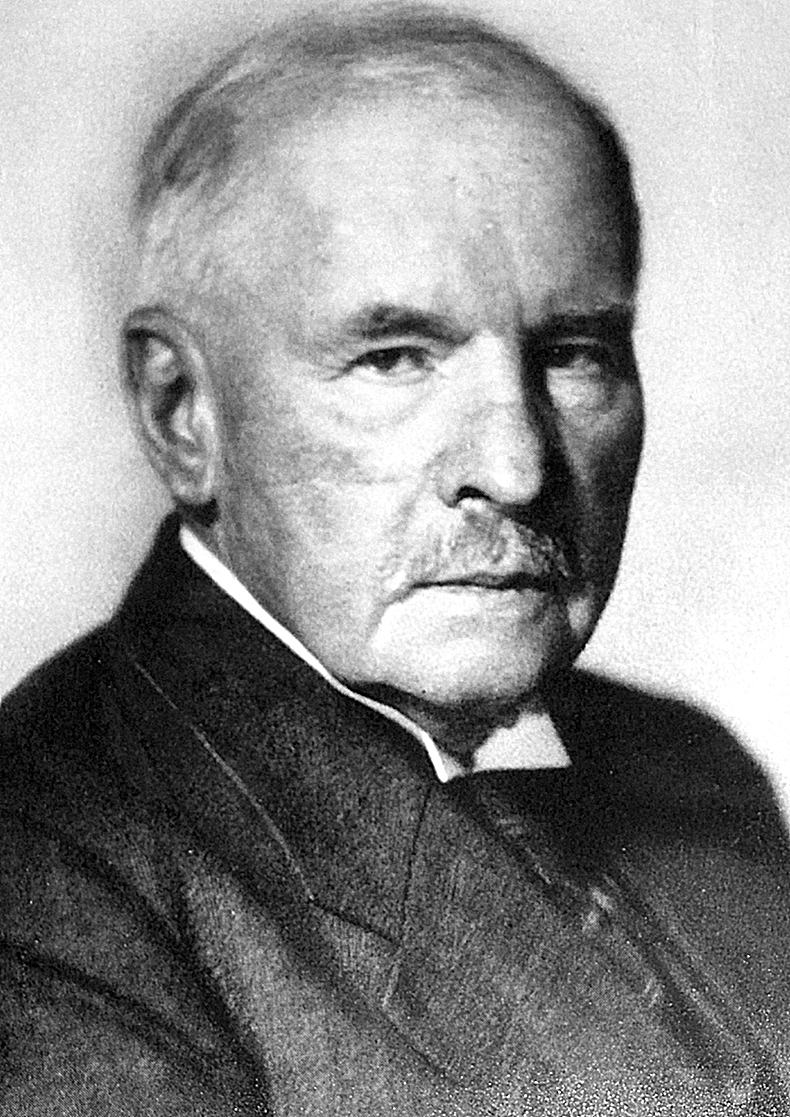
Conclusion
Wiegand thus had close connections to the DAI Athens from 1888 until his death. In 1923, in his inaugural speech on the occasion of his admission to the Prussian Academy of Sciences, he expressed how formative his first stay in Athens in particular had been for his development (DAI, AdZ, Biographicamappe Theodor Wiegand, Sonderdruck aus den Sitzungsberichten der Preußischen Akademie der Wissenschaft 1923. Öffentliche Sitzung vom 28. Juni 1923):
»As a student, I wandered to Greece in order to compare with my own eyes the traditional ideal of beauty of ancient art with the surviving monuments. In view of the finds that emerged from the floor of the Acropolis, the ideas of a youthful romantic developed into a passionate love for the clear recognition of great historical and artistic contexts.«
Acknowledgements
First of all, I would like to thank Katja Sporn, who within the framework of the SAG project for digitizing the archaeological collection at the DAI Athens entrusted me with the publication of the material from the villa in Old Phaleron, which constituted the starting point for this paper. I also wish to thank Katharina Brandt, who crucially supported me with her profound knowledge in regard to many questions I encountered during my research. I am very grateful for the support of the DAI Headquarters Archive, especially Sabine Thänert and Julia Boensch-Bär, during my research. Finally, I would like to thank the Corps Suevia München for making their archive material available to me. The scans were produced by Julia Engelhardt.
Works cited and further reading:
Althoff 2004
J. Althoff, Ein Meister des Verwirklichens. Der Archäologe Theodor Wiegand, in: K. Rheidt – B. Lutz (Hrsg.), Peter Behrens, Theodor Wiegand und die Villa in Dahlem (Mainz 2004) 135–159
Althoff et al 2016
J. Althoff – F. Jagust – S. Altekamp, Theodor Wiegand (1864–1936), in: G. Brands – M. Maischberger (Hrsg.), Lebensbilder. Klassische Archäologen und der Nationalsozialismus 2, MKT 2,2 (Rahden/Westfalen 2016) 1–37
Chatzidimitriou 2019
A. Chatzidimitriou, Οι ανασκαφές του Γερμανικού Αρχαιολογικού Ινστιτούτου στην Αττική. Αναδίφηση στη διοικητική αλληλογραφία της εποχής (19ος-20ός), BGeschArchA 2 (Wiesbaden 2019) 135–152
Cobet 2010
J. Cobet, Theodor Wiegand – das Osmanische Reich und die Berliner Museen, in: C. Trümpler (Hrsg.), Das große Spiel – Archäologie und Politik zur Zeit des Kolonialismus (1860–1940), (Essen – Köln, 2010) 346–353
Kankeleit 2018
A. Kankeleit, Olympia, Griechenland. Der Beginn der neuen Ausgrabungen 1937. Die Arbeiten des Jahres 2017, eDAI-F Fasc.1, 2018, 34–41
Körte 1896
A. Körte, Die Ausgrabungen am Westabhange der Akropolis IV. Das Heiligtum des Amynos, AM 21, 1896, 287–322
Kyrieleis 1981
H. Kyrieleis, Führer durch das Heraion von Samos (Athen 1981)
Lehmann 2003
S. Lehmann, Sport der Hellenen. Die Berliner Ausstellung von 1936 und der jüdische Archäologe Alfred Schiff (1863–1939), Stadion 29, Sonderband Olympische Spiele, 2003, 99–220
Mertens – Conte 2019
J. R. Mertens – L. Conte, Watercolors of the Acropolis. Émile Gilliéron in Athens, BMetrMus, 2019
Puritani et al 2022
L. Puritani – M. Maischberger – B. Sporleder (Hrsg.), Konstantinopel – Samos – Berlin. Verpfändung, Fundteilung und heimliche Ausfuhr von Antiken am Vorabend des Ersten Weltkrieges, Schriften zur Geschichte der Berliner Museen 7 (Heidelberg 2022)
Rheidt – Lutz 2004
K. Rheidt – B. Lutz (Hrsg.), Peter Behrens, Theodor Wiegand und die Villa in Dahlem (Mainz 2004)
Sporn 2020
K. Sporn, Travel and Research. Journeys and Travel Grant Recipients at the DAI Athens, in: K. Sporn – A. Kankeleit (Hrsg.), Die Abteilung Athen des Deutschen Archäologischen Instituts und die Aktivitäten deutscher Archäologen in Griechenland 1874-1933. Tagung DAI Cluster 5 in Athen, Deutsches Archäologisches Institut und Benaki Museum, 12. bis 13. Dezember 2016 (Wiesbaden 2020) 49–66
Vignau-Wilberg 2022
Th. and P. Vignau-Wilberg, Bauzeichnung und Rekonstruktion. Der Bauforscher Wilhelm Wilberg und die Archäologie um 1900 (Regensburg 2022)
Watzinger 1944
C. Watzinger, Theodor Wiegand. Ein deutscher Archäologe. 1864–1936 (München 1944)
Wiegand 1889
Th. Wiegand, Archaische Marmorsimen aus Athen, AD 1 (Berlin 1891) 28 Taf. 38
Wiegand 1890
Th. Wiegand, Archaische Marmorsimen aus Athen II, AD 1 (Berlin 1891) 38 Taf. 50
Wiegand 1894
Th. Wiegand, Die puteolanische Bauinschrift sachlich erläutert, Jahrbücher für classische Philologie Suppl. 20 (Leipzig 1894)
Wiegand 1896
Th. Wiegand, Der angebliche Urtempel auf der Ocha, AM 21, 1896, 11–17
Wiegand 1904
Th. Wiegand, Die archaische Poros-Architektur der Akropolis zu Athen (Kassel 1904)
Wiegand 1970
G. Wiegand (Hrsg.), Halbmond im letzten Viertel (München 1970)
